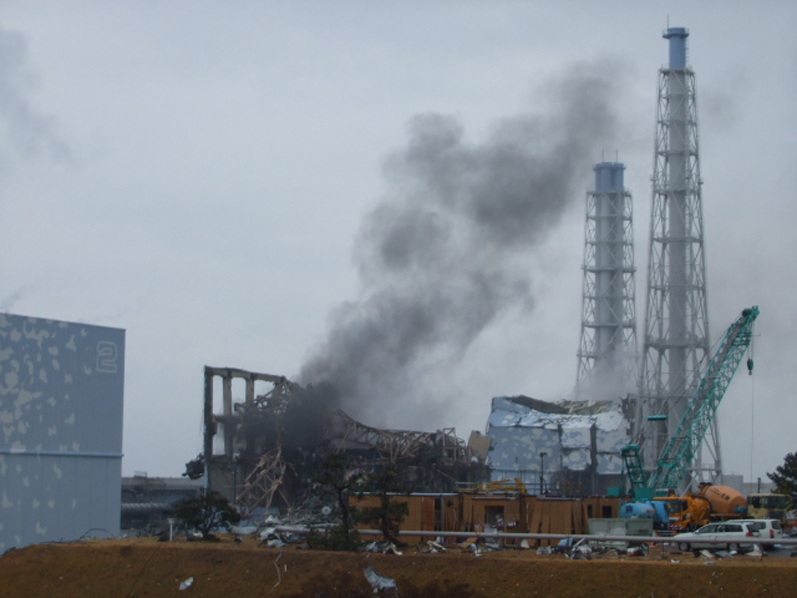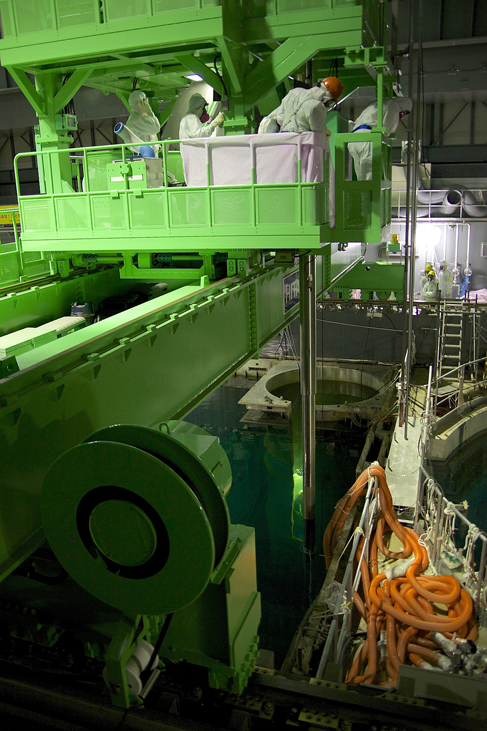Three years after the Fukushima nuclear disaster,
we are hoping to see glimmers of hope

|
Fukushima Daiichi Nuclear Power Station on 21 March 2011, Photo by TEPCO
|
Three years have already passed since the 2011 nuclear accident at Fukushima Daiichi Nuclear Power Station (FDNPS).
No improvement has yet been made to the situation in
which Fukushima residents are suffering from radiation exposure and
140,000 evacuees are still unable to return home. When will “spring”
come for these people? No matter if spring comes to Fukushima and the
mountains and plains are covered with green leaves and flowers as far
as you can see, the invisible danger of radiation continues to exist
deep in the heart of the natural environment. This reminds us of
“Silent Spring.”
The whole picture of the nuclear disaster still
remains unclear. There are plenty of things that are still unknown, or
unaccounted for. Overlooked problems and difficulties are being brought
to light one after another. To determine the causes of the nuclear
accident, many points need to be clarified; where the problems lie and
why they are difficult to deal with. Many of these points still remain
unclear, but some of them are becoming apparent.
The number of people diagnosed with cancer of the
thyroid gland is increasing as the investigation area is expanded. Due
to vagueness in the scientific research, it is still impossible to
declare that the growing number of cancer patients has been caused by
the nuclear disaster. Nevertheless, it is also wrong to say that the
nuclear disaster has nothing to do with the increasing number of cancer
patients. We must deal with this problem by assuming that the health
effects have been caused by the nuclear accident.
Fiscal Year
|
No. of consultations
|
No. of people referred for secondary test
|
No. positively diagnosed with thyroid cancer
|
No. with possible thyroid cancer
|
2011
|
41,561
|
218
|
10
|
4
|
2012
|
139,239
|
987
|
22
|
28
|
2013*
|
88,554
|
591
|
1
|
9
|
Total
|
269,354
|
1,796
|
33
|
41
|
Table 1. Number of People Diagnosed with Thyroid Cancer, 2011 to 2013
* As of December 21, 2013 (Completed results up to November 15)
Source: Fukushima Prefecture, Survey of Prefectural People’s Health Management
|
Among people who have not been directly affected by
the nuclear disaster and those who wish to imagine that the accident
has not inflicted any damage on them personally, we are seeing
spreading signs of a desire to forget about Fukushima and a mood for
tolerating the restart of nuclear power plants because there does not
appear to be any better alternative. However, there is no way to block
the popular movement towards the creation of a nuclear-free society. In
fact, the situation we have now, where all nuclear reactors are
offline, has already been maintained in Japan for as long as six
months.
It is well known that some of the crew members of a
U.S. aircraft carrier engaged in the “Tomodachi” relief operation in
the wake of the 2011 Great East Japan Earthquake were exposed to
radiation emanating from the crippled FDNPS. In February, nearly three
years after the accident, a total of 79 aircraft carrier crew members
filed a class-action law-suit against Tokyo Electric Power Co. (TEPCO),
demanding approximately 100 billion yen in compensation.
At the accident site, operations are currently proceeding to cope with several problems.
Transfer of the nuclear fuel from the Unit 4 spent
fuel pool to a ground-level pool has been continuing since November
2013 (see NIT 158). TEPCO plans to complete the removal and transfer of
all of 1,535 fuel assemblies by the end of 2014.
The transfer of 528 fuel assemblies had been
completed as of March 24, 2014. Three damaged fuel assemblies have been
stored in the spent fuel pool since the pre-accident period. The task
of lifting and removing these fuel assemblies will be a very difficult
operation.

|

|
Operations in Unit 4 spent fuel pool, Photo by TEPCO
|
Storage tanks at Fukushima Daiichi, Photo by TEPCO
|
The serious problem of how to deal with
contaminated water suddenly emerged in July 2013. This is one of the
problems that is making the nuclear accident clean-up very difficult.
In early April 2011, it became evident that a great amount of
radioactive contaminated water had leaked into the sea from the Unit 2
water intake. The then Democratic Party of Japan government tried to
take necessary measures but TEPCO made one excuse after another to
ignore the government’s instructions.
Currently, 400 tons of circulating coolant water is
daily pumped into the Units 1, 2 and 3 buildings in order to maintain
the melted uranium fuel assemblies there in a cool state. Furthermore,
another 400 tons of underground water is flowing into the reactor
buildings each day, increasing the amount of radioactive contaminated
water. The polluted water is currently collected and stored in
above-ground tanks, but sooner or later there will be nowhere to place
new tanks. Radioactive contaminated water leaks caused by deterioration
of the tanks have already occurred at the plant (see NIT 156).
It would be correct to say that the radioactive
contamination level of the soil in the nuclear power plant is totally
unknown. However, the soil is undeniably severely contaminated.
Earlier, in February, the highest-ever level of cesium (134+137)
measuring 130,000 Bq/kg was found in a 16m-deep monitoring well located
next to the Unit 2 building, near the seashore. There is no guarantee
that this record will be left unbroken for long. It will be extremely
difficult to block the contaminated water leaks into the sea. As for
contamination by beta nuclides, no information has been provided so
far.
The water storage tanks contain strontium and other
beta-emitting nuclides. It remains uncertain what kind of nuclides and
how much of them are contained in the tanks. It was disclosed on
January 9 that a non-negligible level of X-rays from the bremsstrahlung
radiation*, caused by beta-rays, was detected around the tanks. This
means that the workers engaged in the work near the tanks are certain
to be exposed to this radiation.
The operation to build frozen walls around Fukushima
nuclear power plant to stem leaks of radioactive water from the reactor
buildings into the sea began in late January. TEPCO says that the
verification test for drilling coolant-filled pipes into the ground
will be completed before the end of March. Since this is a huge and
challenging
operation, there is no guarantee that it will be successful.
At present, the Nuclear Regulation Authority (NRA),
without hearing any opinions from the members of the National Diet of
Japan Fukushima Nuclear Accident Independent Investigation Commission
(NAIIC), is said to be formulating a conclusion that the nuclear
accident at Fukushima nuclear power plant was caused by the
tsunami.
The only official panel that is still continuing
investigations into the cause of the nuclear accident is the Technical
Committee of Niigata Prefecture (see NIT 157). A prevailing view among
Niigata residents is that the issue of whether Kashiwazaki-Kariwa
nuclear power station can be restarted should be discussed after the
committee’s investigation is completed. We hope that the view expressed
by NAIIC member Mitsuhiko Tanaka, NAIIC cooperative member Yoshinori
Ito, and other experts that the nuclear accident was not caused by
tsunami, but was in fact caused by the earthquake preceding it, will
contribute to the pursuit of truth about the accident.
(By Yukio Yamaguchi, Co-Director of CNIC)
*bremsstrahlung radiation
When an electrically-charged particle moving at high speed is
obstructed by the electric field from an atomic nucleus and comes to a
halt, or when the direction it is moving in is altered, the particle
radiates energy in the form of electromagnetic waves. This phenomenon
is called bremsstrahlung radiation.
Return to CNIC's
Earthquakes and Nuclear Power page
Return to NIT 159 contents

